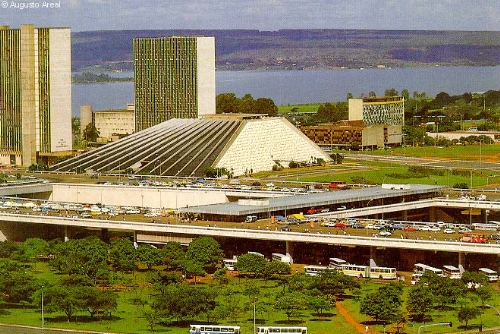This was the Future, Vol.34
typed for your pleasure on 27 July 2007, at 12.23 pmSdtrk: ‘Ceremony’ by Joy division
One of the reasons I prefer architecture — and by some extension, city planning — from the very late Fifties to the very early Seventies, is that there was still a sense of general optimism. Especially during the Sixties, when new technological innovations were popping up on a regular basis, man was setting foot on the Moon, and space travel was a new and fantastic thing. (Although there’ll be something to be said when space travel is no more unusual than taking a trip from one country to another.) It was this exact sort of well-meaning thinking that inspired the subject of this instalment: Brasília, the futuristic capital of Brazil, designed by the architects Oscar Niemeyer and the urban planner Lúcio Costa.

Teatro Nacional (National theatre) ‘Cláudio Santoro’
Photo © by Augusto Areal
In 1956, Juscelino Kubitschek de Oliveira is elected President and creates the Company of Urbanization of the New Capital (NOVACAP). Kubitschek invites a young architect, Oscar Niemeyer, to command the project. In the same year of 1956, the work on site starts. In 1957, a public contest is won by urbanist Lúcio Costa, who presented the inovative ideas for the design of the new capital, in his work which became known as Plano Piloto (Pilot Plan).
Juscelino Kubitschek, or JK, had the motto “fifty years in five”; his plan was to make Brazil grow during his five year term as much as the previous fifty years; JK invited car makers (like Ford, GM and Volkswagen) to come to Brazil, and opened several highways (in detriment of railways) to stimulate cars selling. However, JK’s darling was Brasília; to have the city finished still during his term, he didn’t hesitate in allocating financial and human resources into the works; several Boeings were rented to fly cement, sand and other supriments into the sites.
Juscelino was so obsessed with the idea of being founder of Brasília, that he officially opened the city on April 22 1960, before it was finished.
taken from this site
Considering that only five years before the city existed, it was a barren wasteland, that makes this urban accomplishment all the more impressive. Apart, of course, from the fact that all the main structures of the city, such as the Presidential Palace, the Federal Chamber, the residential sectors, the Supreme Federal Court, and the Brasília Cathedral, among many others, are all disparate, yet uniform. Kinda like the Bauhaus School, but filtered through 20th century Modern aesthetics… entirely lovely stuff.
The dichotomy of Brasília is that it’s classified by the United Nations agecy UNESCO with the status of Historical and Cultural Heritage of Humanity, due to its uniqueness. As I recall reading somewhere, this effectively means that the city is trapped in an architectural timecapsule — changing or updating the overall aesthetics of the city would be the equivalent of placing an enormous flat-screen monitor behind Lincoln’s head in the Lincoln Memorial. Some say that this handicaps the city’s ability to compete with the modernity of more contemporary cities across the globe, but I’m certain I echo many peoples’ sentiments when I say, ‘so what?’ Just because something is new or modern doesn’t necessarily mean that it’s good. Besides, we need cities like Brasília to show future architects and city planners how things can be more effectively managed.
But seriously, a citywide monument to Sixities architectural design? Fantastic
Random similar posts, for more timewasting:
Dig my Future home of the Past in the Future on January 7th, 2005
This was the Future, Vol.38 on June 1st, 2009














July 27th, 2007 at 8.41 pm
Makes me wish I knew Portuguese, but then again, what doesn’t?
“Kinda like the Bauhaus School, but filtered through 20th century Modern aesthetics”
I’m pretty sure that Bauhaus was a 20th century modernist aesthetic, but I’m no expert.
July 28th, 2007 at 1.40 am
Portuguese = alternate universe Spanish
Usually, when I come across structures, furniture, or design labelled as ’20th century Modern’, it references the years of the late Fifties to early Seventies — that whole pop / plastic is king / looks like how early Stereolab sounds style. Cos I mean technically, Art deco was during the 20th century, as was Brutalism, but those are two styles far and away from, say, anything Eero Aarnio did, for instance.
July 28th, 2007 at 7.20 am
Better to say “space age” then, as what you describe more neatly fits and wouldn’t be as confusing to uninitiates like myself. My wife has a Goofy(tm) lava lamp next to her bed.
He’s been decapitated, yet the tips of his dangly ears remain attached to his vacant shoulders. I thought this would be heart-warming news to you.
July 29th, 2007 at 10.25 pm
Planned communities have an intrinsic beauty. Everything fits, and all needs are met for a specific moment in time. But as a planned community, it’s vision of the future is pre-set, and if the future does not arrive as planned it becomes an anachronism. The planning itself hobbles the community. Dynanmicism and diversity cannot be planned, and they have always been the engines of progress.
Planned communities may be beautiful and stylish, but the most successful cities are eclectic, chaotic, and willing to embrace change.
And planned communities are only as cool as the planner. Hitler and Speer had an idea for a world capital of Germania. Wouldn’t it suck if that got built?
July 30th, 2007 at 8.11 pm
Will is the segment producer….so esentially ‘Will’ will be the one to tell me if I’m going to be on the show or not…
It still doesn’t really make any sense. Oh well.
I owe you some piccies, huh?
well I adore you Davecat! Kisses to Sidore from my face 11 ‘Tiffany’, she’s quite the hussy.
🙂
Stacy
July 31st, 2007 at 2.46 am
SafeT –
You’re right, ‘space age’ is probably a better and more fitting term. Plus, I tend to hear analogue blooping in my head whenever that term’s used, which is always good.
Mahtek –
That’s always the ‘problem’ with planned communities — you get a bunch of planners that decide that such-and-such method of living is the way things will be in the future, but things never go as planned. A good example would be the House of the Future; it sported an airplane hangar, as airplanes were supposed to be commuter vehicles that every American would own by the Fifties, or whatever myopic far-off time they pictured.
I completely agree; dynamism drives progress, but we can’t forget what once was, or what could’ve been…
And Germania would’ve been, at the very least, interesting! There was that opera house that would’ve been so outrageously enormous that, when filled with an audience, the collective condensation would form actual clouds below the ceiling. That’s completely mental! But dictators always think big when it comes to architecture. Some would say there’s some overcompensation issues, but I’m not that cynical. 🙂
Stacy-chan –
Yes, you owe me some pics, but I’m too nice to ask. 😉 Hope the book shooting/planning/layout/etc is going as planned, and give your sexatronic hussy Tiffany kisses from Shi-chan and myself!
July 31st, 2007 at 10.27 am
Disney made a planned community….
July 31st, 2007 at 10.09 pm
Speaking of which, have you (DC) seen the original Disney proposal film for EPCOT? It would have been a pretty interesting thing to see if they had built a functioning community as they originally planned. Remind me to show you the DVD.
August 1st, 2007 at 6.44 pm
Zip, don’t forget to show DC the DVD.
August 5th, 2007 at 1.51 pm
He did forget. But then, I forgot to remind him.
Mental note: take more physical notes.